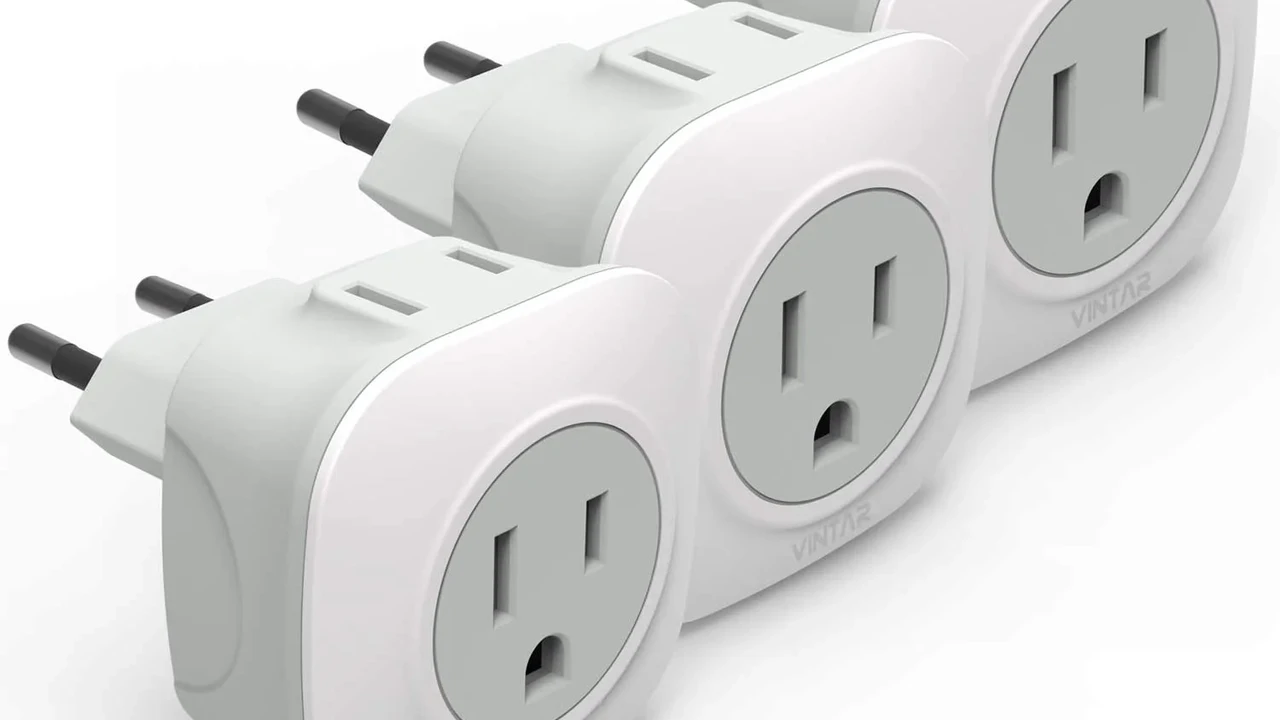Europe Travel: Power Adapters for US Electronics
OK, here's the expanded article content for "Planning Your European Trip," focusing on power adapters for US electronics, incorporating your specific requirements. Remember, this is *just* the article content, no extra fluff.Sample meta description.

Understanding European Voltage and Plugs A US Traveler's Guide
So, you're heading to Europe! Awesome! But before you pack your bags and dream of croissants and cobblestone streets, let's talk about something crucial: keeping your electronics powered up. US electronics run on 110-120V, while most of Europe uses 220-240V. Plugging your beloved phone or laptop directly into a European outlet without the right adapter (or worse, a converter) could result in fried circuits and a very sad vacation. This guide will walk you through everything you need to know about power adapters and converters for your European adventure.
Power Adapters vs Power Converters What's the Difference for European Travel
First things first: adapter versus converter. They're not the same! An adapter simply changes the shape of the plug so it fits into the European outlet. A converter, on the other hand, changes the voltage. You only need a converter if your device isn't dual voltage. Check the label on your device's power supply (the brick on your laptop charger, for example). If it says something like "100-240V," you're in luck! It's dual voltage and only needs an adapter. If it only says "110-120V," you'll need both an adapter *and* a converter. Using just an adapter with a single voltage device will likely damage it.
Choosing the Right Power Adapter Types for Your European Vacation
Europe uses several different plug types, but the most common are Type C and Type F. Type C is a two-prong, round plug, while Type F (also known as a Schuko plug) is also round but has grounding clips on the sides. Many adapters are universal, meaning they can accommodate both types. When choosing an adapter, consider the number of devices you'll need to charge. If you have a phone, tablet, camera, and laptop, you might want to consider a multi-port adapter with USB charging ports. This will save you space and weight in your luggage. Also, check if the adapter has surge protection. This can help protect your devices from power surges, which can be more common in some parts of Europe.
Top Power Adapter Recommendations for European Travel USB Charging and More
Okay, let's dive into some specific product recommendations. I've used these myself or have heard great things from other travelers:
- Etekcity Power Adapter Universal Travel Adapter: This is a solid all-around choice. It handles multiple plug types, has USB ports, and includes surge protection. It's relatively compact and affordable, usually around $20-$25 on Amazon. Great for charging phones, tablets, and cameras.
- BESTEK Universal Travel Adapter 220V to 110V Voltage Converter: If you *do* need a converter, this is a good option. It converts 220V to 110V and includes several USB ports and standard outlets. It's a bit bulkier than a simple adapter, but it's necessary if you have single-voltage devices. Expect to pay around $35-$45. Use case: Vintage hair dryer.
- Saunorch International Power Adapter: This adapter is super compact and lightweight, making it ideal for minimalist travelers. It covers a wide range of plug types and includes USB charging. It's typically priced around $15-$20. Use case: charging a phone and e-reader.
- Epicka Universal Travel Adapter: Offers 5 USB ports and one USB Type-C port, allowing for multiple devices to be charged simultaneously. Offers fast charging capabilities. Priced around $25-$30. Use case: Charging multiple phones, tablets, and a portable gaming device.
Power Adapter Product Comparison Features Price and Travel Use Cases
Let's break down the differences between these adapters:
| Adapter | Price (Approx.) | USB Ports | Voltage Conversion | Size/Weight | Best For |
|---|---|---|---|---|---|
| Etekcity | $20-$25 | 2 | No | Compact | General travel, phones, tablets |
| BESTEK | $35-$45 | 4 | Yes | Bulky | Single-voltage devices, multiple devices |
| Saunorch | $15-$20 | 2 | No | Very Compact | Light travel, minimal devices |
| Epicka | $25-$30 | 6 (5 USB-A, 1 USB-C) | No | Medium | Charging multiple devices simultaneously, fast charging |
When choosing, consider your specific needs. If you only need to charge a phone and a tablet, the Saunorch might be perfect. If you have a vintage hairdryer that's only 110V, you'll need the BESTEK. And if you're traveling with a group and everyone needs to charge their devices, the Epicka will be a lifesaver.
Using Power Strips and Surge Protectors Safely in Europe Travel Tips
Bringing a power strip from the US to Europe is generally not recommended unless you're also using a voltage converter. Even with an adapter, the power strip itself is designed for 110-120V, and plugging it into a 220-240V outlet could damage it and any devices plugged into it. If you need to power multiple devices, it's better to get a European power strip or a universal travel adapter with multiple outlets and USB ports. Surge protectors are a good idea, especially if you're traveling to areas with unstable power grids. Look for travel adapters that include surge protection.
Safety Tips for Using Electronics Abroad Avoiding Damage and Electrical Hazards
A few extra safety tips: Always check the voltage rating on your devices before plugging them in. Don't overload outlets. If you're using a converter, make sure it's rated for the wattage of the device you're using. And never use damaged cords or adapters. If you're unsure about anything, it's always better to err on the side of caution and consult with an electrician or experienced traveler.
Finding Power Outlets in Europe Airport Hotel and Public Space Locations
Finding power outlets in Europe can sometimes be a challenge. Airports usually have charging stations, but they can be crowded. Hotels typically have outlets in the rooms, but it's always a good idea to bring a multi-port adapter so you can charge multiple devices at once. Public spaces like cafes and train stations may also have outlets, but they're not always readily available. It's a good idea to carry a portable power bank as a backup, especially if you're going to be spending a lot of time on the go.
Dealing with Different Plug Types in Europe A Country by Country Guide
While Type C and Type F are the most common, some countries in Europe use different plug types. The UK, for example, uses Type G (a three-prong plug). Switzerland uses Type J. Italy uses Type L. It's always a good idea to research the specific plug types used in the countries you'll be visiting and bring the appropriate adapters. A universal travel adapter will usually cover most of these, but it's always best to double-check.
Travel Power Adapter Reviews and Recommendations User Experiences
Check online reviews before buying a travel adapter. Look for reviews from other travelers who have used the adapter in Europe. Pay attention to reviews that mention the adapter's durability, ease of use, and compatibility with different devices. Also, consider the warranty and return policy. A good adapter should last for multiple trips, but it's always good to have some protection in case something goes wrong.
Sustainable Travel Power Options Eco-Friendly Adapters and Chargers
If you're concerned about the environmental impact of your travel gear, look for eco-friendly power adapters and chargers. Some companies are now making adapters from recycled materials or using more sustainable manufacturing processes. You can also reduce your environmental impact by using a single, high-quality adapter instead of buying multiple cheap ones.
DIY Power Solutions for European Travel Alternative Charging Methods
While not recommended as a primary solution, there are some alternative charging methods you can use in a pinch. You can try charging your devices through your laptop's USB port, but this will drain your laptop's battery. Some hotels may have USB charging ports built into the walls or furniture. You can also try asking at the front desk if they have any spare adapters you can borrow. But remember, always prioritize safety and use reputable charging methods.
Power Adapter Troubleshooting Common Issues and Solutions
Sometimes things go wrong. If your adapter isn't working, first check to make sure it's properly plugged into both the outlet and your device. Make sure the voltage switch (if there is one) is set to the correct voltage. Try a different outlet to rule out a problem with the outlet itself. If you're using a converter, make sure it's properly grounded. If you've tried all of these things and your adapter still isn't working, it might be faulty and need to be replaced.
Packing Checklist Essential Electronics and Power Accessories
Here's a quick packing checklist to make sure you don't forget anything: Universal travel adapter, Voltage converter (if needed), USB charging cables, Portable power bank, Power strip (European or with converter), Camera and accessories, Phone and charger, Laptop and charger.
Staying Connected in Europe Mobile Data SIM Cards and WiFi Access
While this article is primarily about power, it's worth mentioning how to stay connected in Europe. Consider getting a local SIM card for your phone. This will give you access to mobile data at local rates, which can be much cheaper than roaming charges. Many cafes and hotels offer free WiFi, but the quality can vary. A portable WiFi hotspot can be a good option if you need reliable internet access.
Budgeting for Electronics on Your European Trip Costs and Considerations
Don't forget to factor in the cost of power adapters and converters when budgeting for your trip. A good adapter can cost anywhere from $15 to $50, and a converter can cost even more. Also, consider the cost of replacing any damaged electronics. It's always a good idea to have travel insurance that covers electronics.
:max_bytes(150000):strip_icc()/277019-baked-pork-chops-with-cream-of-mushroom-soup-DDMFS-beauty-4x3-BG-7505-5762b731cf30447d9cbbbbbf387beafa.jpg)






